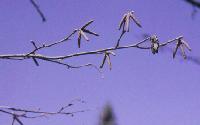Genus: Ostrya
Nomenclature
Ostrya Scop., Fl. Carn. 414. 1760, nom. cons. TYPE: Ostrya carpinifolia.Zugilus Raf., Fl. Ludov. 159. 1817. TYPE: Unknown.
List of Ostrya Species
References to Ostrya
- Abbe, E. C. 1933. The inter-relationship of the genera of the Betulaceae, based on anatomical studies of the inflorescence, the flowers, and the secondary xylem. MS Thesis Harvard Univ.,
- Abbe, E. C. 1935. Studies in the phylogeny of the Betulaceae. I. Floral and inflorescence anatomy and morphology. II. Extremes in the range of variation of floral and inflorescence morphology. Bot. Gaz. 97: 1-67.
- Abbe, E. C. 1930. The anatomy and morphology of the staminate inflorescence and flowers of the Betulaceae. M.S. Thesis Cornell Univ., Ithaca, NY33 plates + 30 p.
- Anderson, E.; Abbe, E. C. 1934. A quantitative comparison of specific and generic differences in the Betulaceae. J. Arnold Arbor. 15: 43-9.
- Balter, H.; Loeb, R. E. 1983. Arboreal relationships on limestone and gneiss in northern New Jersey and southeastern New York. Bull. Torrey Bot. Club 110: 370-9.
- Cathey, H. M.; Campbell, L. E. 1975. Security lighting and its impact on the landscape. J. Arboric. 1: 181-187.
- Chen, Z. D.; Manchester, S. R.; Sun, H. Y. 1999. Phylogeny and evolution of the Betulaceae as inferred from DNA sequences, morphology, and paleobotany. Amer. J. Bot. 86: 1168-1181.
- Coladoanto, M. 1992. Ostrya virginiana. ()
- Collingwood, G. H. 1944. Eastern hophornbeam. Amer. Forests 50: 30-1.
- Dandy, J. E. 1969. Nomina conservanda proposita (267) 1885. Ostrya Scopoli. Taxon 18: 465.
- Davis, W. T. 1896. The hop-hornbeam at the Narrows. Proc. Nat. Sci. Assoc. Staten Island 6 (Dec. 12): 9.
- Delcourt, H. R.; Delcourt, P. A. 1994. Postglacial rise and decline of Ostrya virginiana (Mill.) K. Koch and Carpinus caroliniana Walt. in eastern North America: predictable responses of forest species to cyclic changes in seasonality of climates. J. Biogeogr. 21(2): 137-50.
- Duncan, W. H. 1950. Preliminary reports on the flora of Georgia. 2. Distribution of 87 trees. Amer. Midl. Naturalist 43: 742-61.
- Ellison, L. A. 1951. Occurrence of hop hornbeam (Ostrya virginiana) on Staten Island. Proc. Staten Island Inst. Arts 13: 70-1.
- Fehrenbach, B. 1984. The hop hornbeam: overlooked in the understory. Arbor. Leaves 25(3): 6-8.
- Fehrenbach, W. E. 1984. The eastern hop hornbeam: its natural history and landscape potential. Arnoldia (Jamaica Plain) 44(2): 23-7.
- Fernald, M. L. 1936. Plants of the Outer Coastal Plain of Virginia. Rhodora 38: 376-404,414-52.
- Franck, D. H. 1979. Development of vein pattern in leaves of Ostrya virginiana (Betulaceae). Bot. Gaz. 140(1): 77-83.
- Furlow, J. J. 1990. The genera of Betulaceae in the southeastern United States. J. Arnold Arbor. 71: 1-67.
- Greenidge, K. N. H. 1984. Distribution and ecological characteristics of ironwood, Ostrya virginiana (Mill.) K. Koch, in northeastern Nova Scotia. Ann. Missouri Bot. Gard. 24: 265-498.
- Hall, J. W. 1952. The comparative anatomy and phylogeny of the Betulaceae. Bot. Gaz. 113(3): 235-70.
- Hardin, J. W. 1952. The Juglandaceae and Corylaceae of Tennessee. Castanea 17: 78-89.
- Hardin, J. W.; Bell, J. M. 1986. Atlas of foliar surface features in woody plants: IX. Betulaceae of eastern United States. Brittonia 38(2): 133-44.
- Jentys-Szaferowa, J. 1975. Studies on the epidermis of recent and fossil fruits of Carpinus and Ostrya and its significance in the systematics and history of these genera. Acta Palaeobot. 16: 3-70.
- Kerr, W. C. 1896. A tree new to our flora (Ostrya virginiana). Proc. Nat. Sci. Assoc. Staten Island 6: 3-4.
- Lawrey, J. D. 1977. Trace metal accumulation by plant species from a coal strip-mining area in Ohio. Bull. Torrey Bot. Club 104: 368-375.
- Li, J. 2008. Sequences of low-copy nuclear gene support the monophyly of Ostrya and paraphyly of Carpinus (Betulaceae). J. Systematics Evol. 46: 333-340.
- Marquis, R. J. 1991. Physiological constraints on response by Ostrya virginiana (Betulaceae) to localized folivory. Canad. J. Bot. 69(9): 1951-5.
- McVaugh, R. 1952. Suggested phylogeny of Prunus serotina and other wide ranging phylads in North America. Brittonia 7: 317-346. (And other genera)
- Mitchell, R. S. (eds.) (1990): 1990. Betulaceae through Cactaceae of New York State. Vol. NY State Museum Bull. 476. Univ. of the state of NY, Albany, NY. , 93 pages.
- Paratley, R. D. 1986. Vegetation-environment relations in a conifer swamp in central New York. J. Torrey Bot. Soc. 113: 357-371.
- Peet, R. K. 1984. Twenty-six years of change in a Pinus strobus, Acer saccharum forest, Lake Itaska, Minnesota. Bull. Torrey Bot. Club 111: 61-8.
- Reveal, J. L. 1990. (979) Proposal to conserve the name and type of Carpinus virginiana P. Miller (Betulaceae), the basionym of Ostrya virginiana (P. Miller) K. Koch. Taxon 39: 357-9.
- Spach, E. 1842. Notes sur les Ostrya. Ann. Sci. Nat. Bot. 16: 248-54. (In French)
- Walters, M. B.; Kruger, E. L.; Reich, P. B. 1993. Growth, biomass distribution and CO2 exchange of northern hardwood seedlings in high and low light: relationships with successional status and shade tolerance. Oecologia 94: 7-16.
- Walters, M. B.; Reich, P. B. 1996. Are shade tolerance, survival, and growth linked? Low light and nitrogen effects on hardwood seedlings. Ecology 77: 841-53.
- Woodworth, R. H. 1930. Cytological studies in the Betulaceae. IV. Betula, Carpinus, Ostrya, Ostryopsis.. Bot. Gaz. 90: 108-15.
- Woodworth, R. H. 1931. Polyploidy in Betulaceae. J. Arnold Arbor. 12: 206-17.
- Yoo, K. O.; Wen, J. 2007. Phylogeny of Carpinus and subfamily Coryloideae (Betulaceae) based on chloroplast and nuclear ribosomal sequence data. Pl. Syst. Evol. 267: 25-35.
